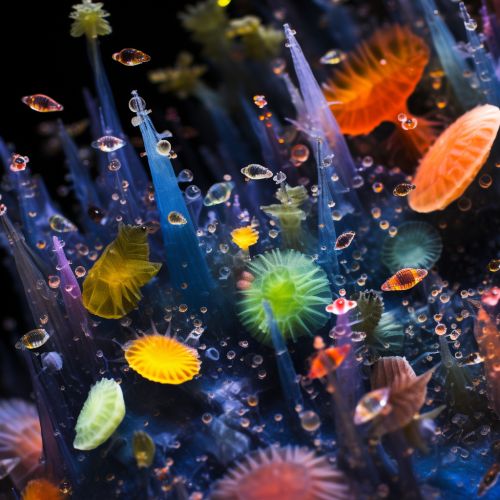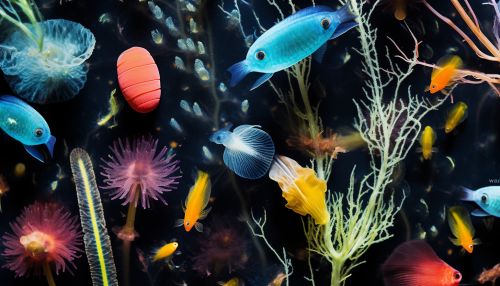Phytoplankton
Introduction
Phytoplankton are the autotrophic (self-feeding) components of the plankton and a key part of oceans, seas and freshwater basin ecosystems. The name comes from the Greek words φυτόν (phyton), meaning 'plant', and πλαγκτός (planktos), meaning 'wanderer' or 'drifter'. Phytoplankton are microscopic organisms that live in watery environments, both salty and fresh.


Classification
Like land vegetation, phytoplankton uses chlorophyll for photosynthesis. However, unlike terrestrial plants, various types of phytoplankton are found in the different classes of protists, as well as bacteria. The main classes of phytoplankton include the diatoms, cyanobacteria, dinoflagellates, green algae, and coccolithophores.
Diatoms
Diatoms are a major group of algae, and are among the most common types of phytoplankton. They are unique in that their cell walls are made of silica, which is essentially glass. This gives them a variety of intricate shapes and patterns, which can be quite beautiful under a microscope.
Cyanobacteria
Cyanobacteria, also known as blue-green algae, are the most ancient lineage of photosynthetic organisms on earth. They are responsible for the oxygen-rich atmosphere we have today. Some cyanobacteria are also capable of nitrogen fixation, which is the process of converting atmospheric nitrogen into a usable form for other organisms.
Dinoflagellates
Dinoflagellates are a diverse group of phytoplankton that are both photosynthetic and heterotrophic, meaning they can consume other organisms. Some dinoflagellates are known for their role in creating red tides, which are harmful algal blooms that can have devastating effects on marine life and human health.
Green Algae
Green algae are a diverse group of phytoplankton that are closely related to land plants. They have chloroplasts that are similar in structure and function to those in land plants.
Coccolithophores
Coccolithophores are a type of phytoplankton that are covered in small, calcified plates called coccoliths. They play a crucial role in the carbon cycle, as they take in carbon dioxide for photosynthesis and release it when they die and sink to the ocean floor.
Ecological Role
Phytoplankton are the foundation of the aquatic food web, the primary producers, feeding everything from microscopic, animal-like zooplankton to multi-ton whales. Small fish and invertebrates also graze on the plant-like organisms, and then those smaller animals are eaten by bigger ones.
Phytoplankton also play a crucial role in the global carbon cycle. They absorb carbon dioxide from the atmosphere during photosynthesis, and when they die, they sink to the bottom of the ocean, effectively removing the carbon and storing it in the deep sea.
Threats and Conservation
Phytoplankton populations are strongly influenced by environmental changes. Factors such as water temperature, light availability, and nutrient availability can all impact phytoplankton growth. Changes in these factors due to human activities, such as climate change and nutrient pollution, can lead to shifts in phytoplankton communities.
Efforts to conserve phytoplankton populations primarily focus on reducing nutrient pollution and mitigating the impacts of climate change. This includes measures such as reducing greenhouse gas emissions, protecting and restoring wetlands, and implementing sustainable agricultural practices.
